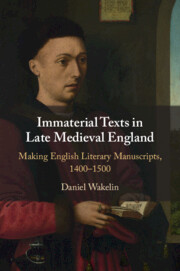Book contents
- Immaterial Texts in Late Medieval England
- Immaterial Texts in Late Medieval England
- Copyright page
- Epigraph
- Contents
- Figures
- Acknowledgements
- Abbreviations, Quotations and References
- Chapter 1 Prologue
- Chapter 2 ‘Hele alle maner of schabbis’
- Chapter 3 ‘Who by prudence Rule him shal’
- Chapter 4 ‘Þe leef torned’
- Chapter 5 ‘Rede … and ʒe may se’
- Chapter 6 ‘This is the copy’
- Chapter 7 Conclusions
- Bibliography
- List of Manuscripts
- General Index
Chapter 4 - ‘Þe leef torned’
Turning beyond the Page
Published online by Cambridge University Press: 12 May 2022
- Immaterial Texts in Late Medieval England
- Immaterial Texts in Late Medieval England
- Copyright page
- Epigraph
- Contents
- Figures
- Acknowledgements
- Abbreviations, Quotations and References
- Chapter 1 Prologue
- Chapter 2 ‘Hele alle maner of schabbis’
- Chapter 3 ‘Who by prudence Rule him shal’
- Chapter 4 ‘Þe leef torned’
- Chapter 5 ‘Rede … and ʒe may se’
- Chapter 6 ‘This is the copy’
- Chapter 7 Conclusions
- Bibliography
- List of Manuscripts
- General Index
Summary
Chapter 4 considers the division of texts into pages and leaves in manuscripts in English poetry and prose in the fifteenth century. It suggests that this material format allowed scribes to fanfare their own craft process, when they decorated the division of the codex into pages for its own sake, as a mere convention without textual function. But it then argues that page breaks contributed little to the text itself. It notes other methods used by scribes to override the page breaks and argued that they were more interested in the continuity of the text and of the reading process beyond the literal limits of the page.
- Type
- Chapter
- Information
- Immaterial Texts in Late Medieval EnglandMaking English Literary Manuscripts, 1400–1500, pp. 112 - 153Publisher: Cambridge University PressPrint publication year: 2022

